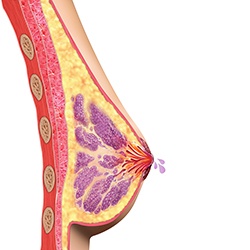Nipple Discharge

Definition
This symptom involves abnormal discharge from the nipple(s)
Considerations
The nature of the discharge can range in colour, consistency, composition, and may occur on one or both breasts may produce a nipple discharge, either spontaneously or when you squeeze your nipples or breasts. A nipple discharge may look milky, or it may be clear, yellow, green, brown or bloody. The consistency of nipple discharge can vary - it may be thick and sticky or thin and watery.
Common Causes
Nipple discharge is a normal part of breast function during pregnancy or breast-feeding. It also may be associated with menstrual hormone changes and fibrocystic changes. The milky discharge after breast-feeding will normally affect both breasts and can continue for up to two or three years after stopping nursing.
A papilloma is a noncancerous (benign) tumor that can be associated with bloody discharge. It appears spontaneously and involves a single duct. Although the bloody discharge may resolve on its own, this situation requires evaluation with an ultrasound of the area behind the nipple and areola. If the ultrasound shows a lesion within a milk duct, you may need a biopsy to confirm that it's a papilloma or to exclude a cancer.
Often, nipple discharge stems from a benign condition. However, breast cancer is a possibility, especially if:
- You have a lump in your breast
- Only one breast is affected
- The discharge contains blood or is clear
- The discharge is spontaneous and persistent
- The discharge affects only a single duct
Are you pregnant?
- Are you breastfeeding?
- What type of drainage is there?
- Does it look like milk (even though you are not breastfeeding)?
- Does it look bloody?
- Does it look like pus?
- Is the drainage from both breasts?
- How much drainage is there?
- Enough to stain the lining of the bra?
- Enough to soak through the bra?
- Does the discharge occur spontaneously, or only when expressed?
- Do you perform breast self-examination? How often?
- What medications do you take?
- Are there any other symptoms present such as:
- fever
- a breast lump
- breast pain
- headaches or change in vision
The physical examination will include examination of the breasts for lumps or other abnormalities.
Possible causes of nipple discharge include:
- Abscess
- Birth control pills
- Breast cancer
- Ductal carcinoma in situ (DCIS)
- Endocrine disorders
- Excessive breast stimulation
- Fibrocystic breasts (lumpy or rope-like breast tissue)
- Galactorrhea
- Injury or trauma to the breast
- Intraductal papilloma (a benign, wartlike growth in a milk duct)
- Mammary duct ectasia
- Mastitis (an infection in breast tissue that most commonly affects women who are breast-feeding)
- Medication use
- Menstrual cycle hormone changes
- Paget's disease of the breast
- Periductal mastitis
- Prolactinoma
Diagnostic tests that may be performed include:
- Breast biopsy (if lump is found)
- Head CT scan to look for pituitary tumour
- Mammography
- Serum prolactin
- Ultrasonography (ultrasound of the breast)
